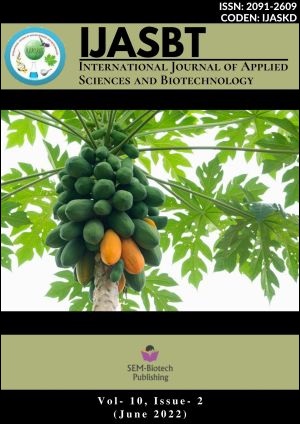Enhancing Production Through Input Use Efficiency of Virus-Resistant Pune Selection-3 Papaya Variety
DOI:
https://doi.org/10.3126/ijasbt.v10i2.46176Keywords:
Papaya, virus-resistant, biochemical changes, nutritional quality, fruit quality parametersAbstract
An experiment was carried out using virus-resistant papaya variety Pune Selection-3 to study the effect of different cultivation methods for enhanced production and input use efficiency at Horticultural Research Farm, RAU, Pusa during the year 2016-2019. The outcomes of raised bed cultivation (a), drip irrigation (b), fertigation (c), polyethylene mulching (d) along with micronutrient spray (e) were analyzed using different combinations of these parameters as treatments for growth, yield-related parameters, and fruit quality. Nutrient use efficiency was also assessed by examining various interactive components such as soil nutrient content, nutrient acquisition with nutrient content in the leaves, the efficiency of nutrient utilization informs of the biomass produced, fruit yield, and fruit nutritional quality. The plant height was maximum in T1 (155 cm) which was significantly higher than the plant of control treatment. The flowering time was found to be reduced in all treatments. However, total soluble sugar was higher in T3. Overall, when the B:C ratio was compared, the treatment (T1) showed a higher value along with a 2.38-fold fruit yield/plant and 0.89-fold increase in fruit yield per hectare. The nutritional quality of fruits enhanced in T1 treated plants having a 1.78-fold increment in flavonoid content, and 1.2-fold more lycopene. The phenolic content was also 1.8-fold higher than the control (T5). The result obtained in the present study demonstrates that with the implementation of a suitable fertigation system in papaya cultivation we can obtain papaya growth, fruit yield per plant, and fruit quality by targeting enhancement in cost: benefit ratio.
Int. J. Appl. Sci. Biotechnol. Vol 10(2): 84-92.
Downloads
Downloads
Published
How to Cite
Issue
Section
License
Copyright (c) 2022 International Journal of Applied Sciences and Biotechnology

This work is licensed under a Creative Commons Attribution-NonCommercial 4.0 International License.




